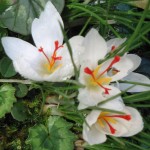At Mower Source, we know it’s important to focus on more than just your grass. Your lawn may be the first thing that people see when they pass by your yard, but the extra somethings planted out there are what will get them to look twice. Bulbs are one of the most popular flowers to plant, and one of the easiest, too. They’re durable, hardy and bloom in vibrant colors, but they do require a bit of strategy to get them to that show-stopping level. Read on to learn how you can get your neighbors thinking you’re a master gardener, and don’t forget to visit our sister site, Snow Blower Source, to score amazing deals on snow blowers.

.
Plant Some of Your Bulbs Now in the Fall
One of the “tricky”, if we can call it that, things about bulbs is they need a bit of time to really take root. They’re not like other flowers, like impatiens or petunias, that you can plant right away and get instant gratification from them. Bulbs need time underground to develop a root system, which has two effects:
Anchoring: If you’ve ever seen a tree that’s been knocked over by a storm, then you know their root system is massive and goes deep into the ground. Trees are huge, and need a root system that can anchor them into the ground so they don’t blow over at the slightest wind. A good rule of thumb to use is the width of the plant tends to equal the depth of the roots. Bulbs are no different — although they’re not nearly as big as trees, they still need to be held firmly into the ground, and planting them in the fall helps stimulate this growth so that by the time they bloom in the spring (some of the year’s first bloomers), they’ll be solidly in place.
Nourishment: Some bulbs need to have a season’s worth of underground time to ensure the stems, foliage and flowers that show up in the spring will be at maximum peak. Think of it this way — if you stayed inside all the time and only ate 1,400 calories, you wouldn’t die, but you would be pale and a little malnourished. Spring-blooming bulbs, because they need a bit of extra time in the earth, need their equivalent of sun and caloric intake, which is a decently long rest period. And not to worry: spring bulbs have their own sort of antifreeze that protects them against winter’s chill.

.
Types of Spring-Blooming Bulbs to Plant in the Fall
Not all bulbs need to go in the ground right now. Some prefer warmer soil and hotter temperatures and go in the ground in the spring. But others, like this little list, do best when planted now.
Tulips
Crocuses
Hyacinths (also, Grape Hyacinths)
Daffodils
Snowdrops
Allium
Anemones
Freesias
Bulbs That Bloom Later in the Season
If you live in Zone 8, 9 or 10 (generally where the winters are milder), then you can get away with planting summer bulbs in the spring. The soil won’t be so cold as to freeze the bulbs, and you’ll get a showy bloom later on in the season, too. Here are a few choices to pick from.
Dahlias
Gladioli/li>
Calla and canna lilies
Tuberous begonias (not to be confused with fibrous begonias, which are grown from seeds instead of bulbs)
Caladium
Oriental lilies
Scadoxus (also known as “fireball lily”)
Bearded Irises
There are also fall-blooming bulbs, but mentioning those would be a moot point right now because it’s too late in the season to plant them.

.
Tips for Planting Bulbs so They’ll Bloom Well
If there’s one complaint gardeners have about bulbs, it’s their brief bloom period. They don’t tend to flower for very long, but a good gardener uses bulbs to stagger the bloom in their garden so there’s always something showy going on from early spring to late fall. But to get that first vibrant bloom once the winter thaws away, it’s important to practice these tips.
Spacing: One of the biggest mistakes rookie gardeners make is not spacing their plants appropriately. It takes perennials two to five years to reach their mature size, which means how they look in their first spring isn’t how they’ll end up finally (think of your growth from infant to adult). Read the information on the plant tag carefully, and space the bulbs according to their mature size (e.g. tulips and daffodils should be planted about 6-8″ deep and about 4-6″ apart).
Drainage: There are some plants, like ligularias, adore wet, soggy soil. Bulbs do not. They need soil that’s well-drained, otherwise they’ll rot and you’ve lost your plant. Remember to adapt the plant to the soil because trying to do it the other way around is in vain.
Watering: Once you’ve planted your bulbs, water them to give them a kick start on growth. After that, the roots should generally be fine and you won’t have to worry too much about watering until the spring.
Bugs: Nothing is more tragic than seeing insects chew up the plants you’ve so carefully tended to. Add a bit of fertilizer to the soil, and top it off with insecticide appropriate to the bulbs.
Bulbs are one of the easier flowers to plant because they’re so low-maintenance, but the thing to remember about them is most of the work involved takes place way ahead of time. Right now is the optimal time to start planting bulbs because soon enough, the weather will be too cold to plant them in the ground. When that happens, the only thing you have to worry about is getting yourself a good snow blower, so check out Snow Blower Source for mind-boggingly good deals. From now until October 31st, you can save a lot of money on snow blowers and just like bulbs, preparation and advance planning is key for success. And remember that anything you buy from Mower Source comes with free, fast shipping.









